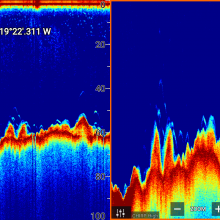This article may contain affiliate links. If you make a purchase after clicking on a link we may earn a small commission at no extra cost to you. As an Amazon Associate, I earn from qualifying purchases.
What is CHIRP Sonar?

CHIRP based sonar uses a range of different frequencies to give a much clearer picture over regular sonar that will use a single frequency per burst.
Standard sonar(SOund NAvigation and Ranging) generally sends a single or fixed burst of sound waves from the transducer towards the bottom and records the time for it to return and the strength of the returned wave.
Some objects depending on their size, shape and what they are made up of will reflect certain frequencies better than others.
If you can send multiple burst of varying frequencies you will be able to get much clearer separation and deeper penetration in term of depth.
This is effectively how CHIRP sonar works.
Most modern fish finders that have integrated CHIRP will give a much clearer picture than when using a single frequency beam.
They will also perform better at deeper depths than regular sonar.
What is CHIRP Sonar ?
CHIRP (Compressed High Intensity Radar Pulse) is a more advanced type of sonar that uses multiple bursts of varying frequencies that gives better separation, deeper penetration and a higher signal-to-noise ratio.
Traditional sonar will generally be restricted to one or two frequencies.
Certain frequencies will be reflected better off of some objects and worse off of others.
By varying the range of frequencies in a burst the returning sound waves will give you the best possible signal that the processor or head unit can utilize to transform into a picture on the screen of a fish finder.
The end result is a much crisper separation of underwater objects and a potentially higher resolution on your screen.
Traditionally 2D sonar uses 200 kHz as the most common operating frequency.
That means one continuous pulse at 200 kHz, with CHIRP sonar however there is a constant cycling through a range starting low and building to high.
The end result back to the transducer is a considerably higher amount of signals that can be combined by the head unit to give a superior read of the waters below.
CHIRP Fish Finder
One of the biggest advantages of a CHIRP fish finder over a standard sonar unit is that what was once a large bait ball on the sonar unit can now become much clearer even to the point where you can see individual fish.
Before any predator chasing the bait ball would most likely have shown up as part of the bait ball but when using CHIRP sonar you can get a much clearer separation between the two.
All of the major brands now integrate CHIRP into almost all of their units, however a lot of the base models will only run standard sonar with a fixed frequencies.
The Humminbird Helix 5 for example has several available units that support CHIRP but the base model is only available with standard sonar.
It can often be used to run in parallel with down-imaging or side-imaging functionalities to give even clearer pictures at varying depths.
